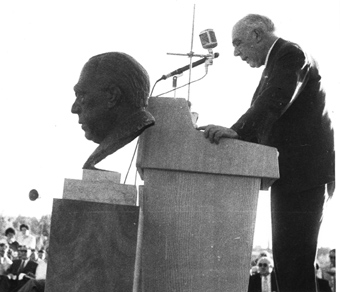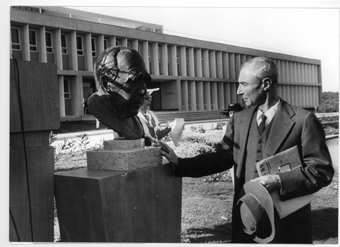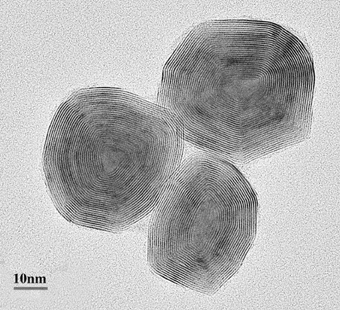Letter from Israel Sieff to Chaim Weizmann
Dear Chaim,
I want the striving for practical achievements to be accompanied by the discovery of knowledge for its own sake. Perhaps because I am myself a practical business man, my mind is much more attracted to pure science. I forget who it was that said: “In our most theoretical moods we may be nearest to our most practical applications.”
March 13, 1934
Source: Weizmann Archives
70 years ago
The garden party that took place yesterday afternoon at Dr. Weizmann’s villa in Rehovot was attended by some 400 men and women from Tel Aviv and various parts of Eretz-Israel. The guests were received by Mrs. Weizmann, and when Dr. Weizmann returned from the meeting of the partition committee in Jerusalem at 6 pm, he also performed his duties as a host by treating his guests with great hospitality.
WIZO’s “Women’s Fund,” which Mrs. Weizmann sought to benefit by holding the party at her house, gained several hundred Israeli pounds.
Ha’aretz (translated from Hebrew),
May 17, 1938
60 years ago
Today, the one peaceful spot in all of Palestine is the brand-new Weizmann Institute of Science. Nestled at Rehovoth, in the midst of orange groves and cypress trees, its scientists are stubbornly disregarding the gunfire and explosions that rattle throughout the land. They are pursuing their own special enemy – the desert.
Science Illustrated,
July 1948
Though warfare of a sort flourishes between Arabs and Jews all around Rehovoth, in this quiet, well-equipped institute with its modern laboratories and extensive scientific laboratory, skilled chemists and physicists constantly are making new discoveries.
New York World-Telegram,
March 22, 1948
55 years ago
A Department of Experimental Biology that will specialize in cancer research was dedicated today at the Weizmann Institute of Science in Rehovot. A few minutes later the cornerstone was laid for a new Institute of Physics.
The New York Times,
November 4, 1953
50 years ago
Science in Israel
The Weizmann Institute – a complex of splendid buildings in a lovely setting of luscious green lawns, tall cypresses and a colourful array of flowers – is lavishly equipped and of an academic standing to rival any laboratory in the Western world.
…The Institute has built its own electronic computer; designed and engineered an isotope separation plant which is the world’s only source of highly enriched oxygen isotopes. … The geneticists, one suspects, are trying to live down the sensational publicity that followed the announcement that they had discovered a method of prenatal sex determination.
The New Scientist,
April 24, 1958
Great Atomic Scientists in Israel
“And now gentlemen, do the photographers a favor and try to look intelligent,” Professor Felix Bloch told his friends Chaim Pekeris, Niels Bohr, Robert Oppenheimer, Meyer Weisgal and Amos de-Shalit. …The travel to the celebrations in Rehovot was Oppenheimer’s first trip outside the US borders: he had been among the leading figures accused by McCarthy’s commission.
…Prime Minister David Ben-Gurion and Oppenheimer used different words to express the same idea: They emphasized that science can be a source of redemption for humanity only if the scientific effort goes hand in hand with eternal values of human morality.
Dvar Hashavua (photo essay, translated from Hebrew), May 28, 1958
Photos: Boris Carmi
40 years ago
We had an impressive meeting at a plant that goes by the modest name Rehovot Instruments, managed by Prof. Joe Jaffe. Since the demand for scientific instruments in Israel is most limited, the plant must be based mainly on exports.
Al Hamishmar (translated from Hebrew),
August 14, 1968
Today: Rehovot Instruments was among the forerunners of El-Op, currently among the leading electro-optics companies in the world.
35 years ago
Dr. Jehuda Yinon of the Weizmann Institute’s Isotopes Department has started developing a device for identifying explosives and drugs. The device is based on new methods of mass spectroscopy measurements.
Ma’ariv (translated from Hebrew),
December 13, 1973
Today: Profs. David Cahen of the Materials and Interfaces Department, Abraham Shanzer of the Organic Chemistry Department and Ron Naaman of the Chemical Physics Department have developed a sensor, called MOCSER, that is capable of identifying materials in minute quantities, consisting of only several hundred molecules.
20 years ago
Science-by-Mail, just starting at the Museum of Science in Boston, is a first-of-its-kind program for American students in grades 4-9. The project began as one of a series of youth-centered programs at the Weizmann Institute of Science in Rehovot, Israel’s major interdisciplinary research facility. The institute directors then invited the Boston Museum of Science to be its first American partner in the enterprise. The goal is to motivate children to explore their surroundings by solving problems, said Moshe Rishpon, director of youth activities at the Weizmann Institute, who came to Boston to launch the program. Scientists at the Weizmann Institute translate the problems into Arabic and other languages to reach wider audiences, Rishpon said.
The Boston Globe,
March 17, 1988
Today: Weizmann's Young@Science section operates science-by-mail and math-by-mail programs with partners in different parts of the world, from Canada to Korea.
15 years ago
Buckyballs without Carbon?
Buckyballs, those little spheres made up of 60 carbon atoms, have been the focus of considerable research over the past few years. They have curious roles ranging from superconductors to hyper-velocity projectiles. Now scientists at the Weizmann Institute of Science in Rehovot, Israel, are finding that other, noncarbon, materials can also form fullerene-like structures, a discovery that may open up a new branch of materials research.
21st Century Science & Technology,
Summer 1993
Today: ApNano Materials develops methods for producing particularly effective lubricants based on inorganic fullerine-like structures.
The Math-by-Mail project is supported by the Abraham and Sonia Rochlin Foundation.
Prof. David Cahen’s research is supported by the M.D. Moross Institute for Cancer Research; the Nancy and Stephen Grand Research Center for Sensors and Security; the Philip M. Klutznick Fund for Research; Mr. Yehuda Bronicki, Israel; and Mr. and Mrs. Yossie Hollander, Israel. Prof. Cahen is the incumbent of the Rowland and Sylvia Schaefer Professorial Chair in Energy Research.
Prof. Ron Naaman’s research is supported by the Nancy and Stephen Grand Research Center
for Sensors and Security; the Fritz Haber Center for Physical Chemistry; the Wolfson Advanced Research Center for Bio Micro Technology; the Philip M. Klutznick Fund for Research; the Carolito Stiftung, Switzerland; and Intel, Israel. Prof. Naaman is the incumbent of the Aryeh and Mintze Katzman
Professorial Chair.
Prof. Abraham Shanzer’s research is supported by the Nella and Leon Benoziyo Center for Neurological Diseases; the J&R Center for Scientific Research; the Helen and Martin Kimmel Center for Molecular Design; the Gerhardt Schmidt Minerva Center on Supramolecular Architectures; and Mr. and Mrs. Mordechai Glikson, Israel. Prof. Shanzer is the incumbent of the Siegfried and Irma Ullmann Professorial Chair.
Prof. Reshef Tenne’s research is supported by the Helen and Martin Kimmel Center for Nanoscale Science. Prof. Tenne is the incumbent of the Drake Family Professorial Chair in


